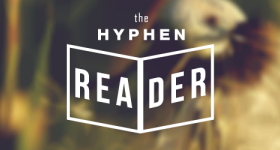SYS: The title, which is so multivalent, has me going in so many directions, which is fantastic. Can you talk about how you came to the title and what it means to you?
LS: I have to give credit for the title to my editor at Bull City Press (who published my most recent chapbook, SEASON OF DARES), Leslie Sainz. It was one of the titles that came up for SEASON OF DARES, but I thought it was more fitting for my full-length collection. I had been sending that chapbook out under another title, “ROUGHAGE,” but Leslie pointed out to me that while that title got at some of the grittiness that the collection involved, ARABILIS “takes it a step forward and acknowledges the specific blend of hope and action that the characters/speakers in your work put to use.”
SYS: I also love what Jericho Brown said in his blurb that “ARABILIS is a book that champions the idea of poetry as prayer.” I am so geeked out about your ministerial studies, inquiries, praxis — are you willing to talk about this idea of poetry as prayer, which I generally subscribe to as well? Does that hold energy for you at all, or is it too general?
LS: The idea of “poetry as prayer” absolutely does hold energy for me, but that energy is always changing and evolving. Jericho Brown’s THE NEW TESTAMENT was a touchstone for me during the process of writing and revising ARABILIS because I saw that “poetry as prayer” idea modeled in his poems. I remember hearing him talk at some point (and I’m paraphrasing here) about how the scriptures that he grew up hearing stuck with him as an adult and would come up for him at various times and in part, THE NEW TESTAMENT was a way of making space for himself within a faith tradition that he didn’t feel made space for him growing up. That was really meaningful to me; throughout this collection, I was trying to navigate my fraught relationship with the evangelical, small-town Christian faith tradition in which I grew up. These poems were, in some ways, a means of “feeling through” those tensions — and a way of using the poem as a way of “praying” — not to a static God necessarily, but the God of my childhood as well as the complicated way I relate to the divine today and in general, the unknowable, the ineffable.
When I’m thinking about this, I am often drawn back to what Fanny Howe writes in her essay collection, The Wedding Dress: "One definition of the lyric might be that it is a method of searching for something that can’t be found. It is an air that blows and buoys and settles. It says, ‘Not this, not this,’ instead of, ‘I have it.’" I feel like poetry, much like prayer, is that state of searching, of a willingness to surrender to the unknown, to feeling through the dark.
In the faith traditions (in the Baptist, then the Pentecostal tradition) I grew up in, prayer was not just about the words we said but how we said them, which is to say, the rhythms, the sounds — the musical form they took. They were, in a way, performances, not just before God but for and within community. Our prayers often began quietly, built in fervor and then ended in a contemplative decrescendo, and I think a lot of what I learned about music in poetry was through the “music” of prayer I absorbed as a child.
SYS: That makes complete sense. “Built in fervor”! I like what good old Li-Young Lee says, “I go into some room in my heart or in my soul where it’s just me and God. Poetry, contemplation, worship, prayer, all of those kinds of things are all in one house but different rooms. When I write poetry I go into that house.” https://chrisricecooper.blogspot.com/2013/07/li-young-lee-gods-hungry-poet.html
I was raised Roman Catholic and it was very much part of my adoptive family’s extended families’ cultures in terms of being Irish and Polish. We went to Mass every Sunday morning at 8:15 and sat in the same pew. I feel like I’m constantly thinking about it in my poetry and poetics but have always felt like kind of an oddball, both under the broader Asian American poetry umbrella and in the world of experimental poetry.
SYS: Are you willing to delve into a little more the ideas and rituals that still resonate with you? And do you see them animating ARABILIS in particular ways you would want to talk about?
LS: I love that quote by Li-Young Lee! I feel like in some ways I was drawn to poetry because it felt like a familiar house, to put it in his terms. My adoptive family also went to church every Sunday (my father was also a deacon and my mom worked in the church office) and we also went to Bible study and youth group — like people used to say in my community, we were at church “any time the doors were open.” And I definitely hear what you are saying about feeling like an oddball in working in that space between/within thinking about religion, the Asian American poetry community and experimental poetry — but that liminal space is also so exciting for me!
One ritual that I’ve been thinking a lot about lately in terms of poetics, was something called an “Object Lesson.” Once a month, one of the kids in the congregation got to bring something to church for an “Object Lesson”: the pastor would take it and tell a story about the way it illustrated some spiritual meaning. When it was my turn, I spent hours searching for something that would stump him: a frayed bit of baling twine, a broken button, a banana peel. I was delighted to observe how he could tell a story about how some aspect of that strange, worn out or defunct object illustrated something about God. Unbeknownst to me, this early introduction to metaphor sparked my interest in the way figurative language serves as a conduit for understanding divine presence in unexpected places. I still resonate with that kind of metaphor-making and find it beautiful. I think that in some ways, that gesture is at the core of ARABILIS, which is to say, the attempt to revisit personal history and world(s) in which I grew up to locate new meaning in them, to find new connections where there was previously only loss or lack.
SYS: “Object Lesson”! That’s so conceptual! That leads me to ask about the seasonal structure, which I think of as, of course, a “mundane” ritual. Did the structure come to you first or later on? And I think the ritual of naming and of genealogy (“begets”) appears in your work, quietly, as place names, in many if not most of the poems. “Boneyard. Field. Forest.” and “Remington, Winchester, Pistol Drive.” These kinds of names also always strike me as cinematic edits, montage, Fisher Price Viewmaster clicking through in a way that is so pleasurable for some reason. I suppose it’s like blinking and opening your eyes to another scene, a way of time travel.
Another question, kind of about poetics, which may or may not relate to anything else, if your inclusion of everyday contemporary objects such as beer cans and Krylon Gold paint along with a lot of Latinate language and straight-up Latin and other kinds of what I would consider sort of “high poetry” diction, “the galley blooms / fruit flies, smoke-winged and garnet-eyed” or just intensely lyrical, tactile, sensual, etc. Is there a conscious poetics there? I ask because it’s something I find myself avoiding but feeling that I should not avoid! I do also want to ask about the anthology project and how you see it intersecting with your work or as an extension of your work, when you started to see a void or a space you wanted to make in contemporary poetry, in particular Asian American poetry/ies ...
LS: As far as the seasonal structure — in the broadest sense, the structure came to me later. I had a collection of poems and was looking for a way to organize them, and so I tried a few different organizational structures but then I began to realize that most of the poems, to me, correlated with a certain season — whether that was some aspect of the season literally appearing in the poem or a more notional connection with the season (spring/rebirth, winter/hibernation, etc.). So in some ways, I think the structure was there in the poems but I didn’t discover it until later.
I wish that I could say that the combination of everyday objects and Latinate language/”high poetic diction” was a conscious poetics — I definitely want to think about that more. But maybe going back to that Object-Lesson idea … my childhood faith tradition, in some ways, taught me poetic sight; I came to believe that everything we did, touched, saw, was imbued with spiritual significance. And I think as a side note relating to “high diction” and everyday happenings and religious ritual — I remember as a kid there would be a lot of this mixing of diction in our prayers — “Almighty and gracious and everliving God,” we might pray, “We pray your protection over So-and-So’s goats who escaped Saturday night.” Interesting now that I think of it, but that kind of interweaving of diction was something I grew up with. The lofty and divine permeated the everyday.
I think that the ritual of naming that appears in the book, in part, an outgrowth of the ways in which I inherited language and situated-ness. An example: growing up in rural Montana, we’d give directions according to landmarks and even now that I live in the city, I still think I relate to space that way, which makes it confusing when I give directions! Naming these places in my poetry is a way of revisiting them — not only in terms of describing physical place but also my relationship to them.
SYS: Actually what is more Biblical than goats — nothing! I always feel a little bit like asking poets about the structure of their book is asking them / us to reveal deep black magic secrets, so please forgive me!
Yes, your rural-based orientation to space makes sense! I also just realized, not sure why I didn’t on the first read, that most of your poems are or have narrative. There’s a significant amount of walking in your poems. Is this something you think about? Do you think about “story” or “narrative” in any particular way? I really enjoy and appreciate your use of verbs, rhythm, the long dash with a space between its end and the next word, the use of caesurae in general.
LS: It’s not something that I consciously thought about, but I think that walking is kind of a way of articulating the speed at which I move through the world and through poetry. Slowly and meanderingly! And again, maybe it’s a way of rooting myself in the world of the collection again — there are cars and roads but it’s a world the speaker moves through mostly by walking.
When I think about “story” or “narrative” — I suppose I think mostly about perspective — why we tell the stories we do and to whom and to what ends? Before I started writing poetry, I wanted to be a novelist, but I think I was less interested in telling stories and more interested in exploring why and how we tell them — fiction can do this as well of course, but I found it was easier for me to explore these ideas through the tools that poetry provided.
SYS: I found the embodied (walking, moving, touching) nature of your poems, a narrator often moving deliberately through a specific place doing specific things, along with your completely transcendent language, sublime, very reassuring somehow. These poems feel lucid, precise. As was the ambiguity or emptiness that I think of as very Asian, very Korean, that haunts the poems and the collection. Or, potentiality? Arability … Also, some motifs I loved are scavenging, robbing, forsaking, forgetting (theft-mercy combo platter? I guess very Jesus-y!) … are these at all informed by [our collective Korean] adoption [experience], or am I projecting? And ... I realize I’ve already taken up over an hour of your life! (I could ask you a million questions; I am so interested in these answers!) My last question will be about the forthcoming anthology — what would you like to share about it, and is there anything else you’d like to say about ARABILIS or any other new projects, work, direction, dreams?
LS: I love that you find them reassuring! Loss, emptiness, ambiguity — I’ve found all of that to be haunting this collection. I think some of that loss is definitely informed by thinking about adoption as well as my movement away from the rural environment of my childhood and my childhood faith … I think for a long time, I felt this intense longing for something to fill this sense of void, of loss — I wanted to find a story, or narrative or a god, maybe, that explained it and also filled it. But I think as time has gone by, I’m wondering if I can think about that loss/void as wound/trauma but also as a site of possibility? Of something that won’t be filled necessarily but as something that provides a way through, a means of contact — a tunnel? I’m thinking of the book club we’ve started with several other Asian American adoptee poets — and my relationships with other adoptees I know — all of our losses take different shapes, but I have found comfort in learning how to inhabit in that space of absence together. I often think about what theologian Simone Weil says in Gravity and Grace:
“The world is the closed door. It is a barrier. And at the same time it is the way through.
Two prisoners whose cells adjoin communicate with each other by knocking on the wall. The wall is the thing which separates them but it is also their means of communication … Every separation is a link.”
Absence takes many forms in this manuscript: death and grief, lacunae on the page, and so much of my work feels like knocking on that wall of separation, then listening to see what might knock back. I grew up feeling quite alone, and I think that some of these poems echo the ways in which I knocked on the walls of the world that surrounded me as a child. It’s only now, decades later, that I feel the world knocking back — whether that’s through people who read and respond to my poems or the poetic persona who inhabits these poems, pointing out the doors and windows where there only seemed to be walls.
In recent years, I’ve been thinking a lot about the relationship between faith and religious traditions and poetry — both my own and those of other poets in the Asian American community. I went online to look for an anthology that might deal with these themes but couldn’t find one. And then I began to think, what if we … made one? I was fortunate that my friend, mentor and fellow adoptee and poet Lee Herrick agreed to come onboard as co-editor. The anthology is titled, THE WORLD I LEAVE YOU: ASIAN AMERICAN POETS ON FAITH AND SPIRIT, and will be published with Orison Books in spring 2020. Working on the book has been an incredible process. I’ve learned so much from these poets and the way they look at the world, poetry, the divine and spiritual practice in its many forms. I’ve begun to think of it as a kind of wall-knocking, to return to that metaphor, and I’ve been delighted to hear so many voices respond! When I was a kid, I longed for satisfying answers to my questions and closure for my spiritual longing. In my journey since then, including working on this anthology, I’ve discovered a different kind of solace through the voices of my community as they sing and speak to one another and dwell together, as Emily Dickinson might say, in possibility.










Comments